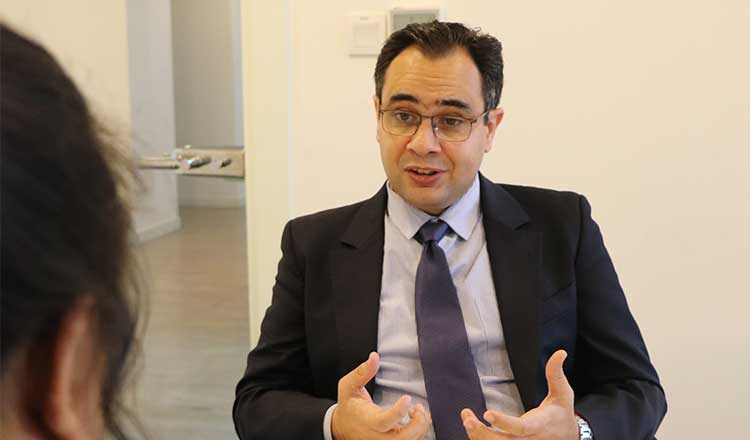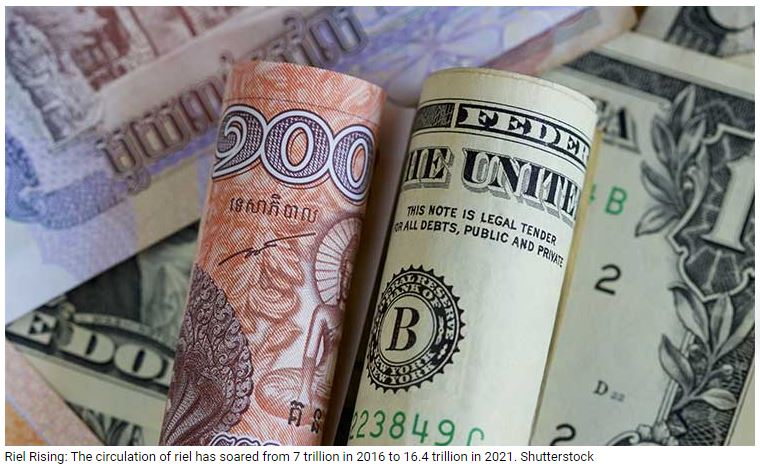Cambodia: De-dollarisation a long-term goal, say financial experts
Cambodia’s macroeconomic stability is of paramount importance to maintain the full confidence of all agents and ensure continued economic growth. The ultimate replacement of the dollar by riel in the Cambodian economy will only take place step by step as both the private sector and the households progressively build their awareness and trust in the national currency, and consequently their willingness to use it
Over the last two decades, Cambodia’s macroeconomic and financial stability created the pre-conditions to promote riel to play its full role as the sovereign currency in all means of payment and settlement.
Mar Amara, Senior EVP and Group Chief Finance Officer, ACLEDA Bank, told Khmer Times, “It is suitable. Still, the best is that it should be step by step to build investors (both existing and in the stage for attracting new investors) confidence. NBC requires all banks and MFIs to have at least 10 percent of the loan portfolio in KHR for all banks and MFIs. NBC also supports the Royal Government which plans to issue government bonds this year. So far, NBC has also supported banks and financial institutions to issue bonds in KHR.”

Blaise Kilian, Co-director, SOSORO Museum, said, “People’s mindset, habit, and network externalities remain among the main barriers to successfully de-dollarise our economy at the moment. Hence, de-dollarisation is a long-term goal. The strategy adopted by the National Bank of Cambodia to achieve this goal is the gradual promotion of riel based on market mechanisms.
Cambodia’s macroeconomic stability is of paramount importance to maintain the full confidence of all agents and ensure continued economic growth. Therefore, the ultimate replacement of the dollar by riel in the Cambodian economy will only take place step by step as both the private sector and the households progressively build their awareness and trust in the national currency, and consequently their willingness to use it.”
RIEL BENEFITS
Ky Sereyvath, Director of the Chinese Study Center and a researcher in economics at the Royal Academy of Cambodia, said, “We can promote riel with the joint efforts of all stakeholders. For example, the government may further reduce its spending (financing) in US dollar, the private sector may open more bank accounts in riel for their staff, and the public should use more riel in their daily business transactions.
The financial expert explained that to encourage the use of the riel, it is necessary to create an enabling regulatory framework for the private sector and raise awareness and build trust among the public.
“Three broad types of measures are currently implemented to achieve this long-term objective,” said Kilian.
First, regulations have been adopted to promote and reward the use of riel in the banking system.
Banks and financial institutions must maintain at least 10 percent of their portfolio in riel. The reserve requirement rate for foreign currencies is set higher than the riel (12.5 percent against 8 percent), but during the Covid-19 crisis, both have been lowered to 7 percent. These measures have been designed to encourage banking and financial institutions to provide more loans in riel.
Second, new instruments have been created to facilitate and therefore promote the use of riel.
These include electronic payment systems such as “Fast Payment” and “Retail Pay” and interoperable QR payment systems that allow Cambodian tourists visiting Thailand and Malaysia to pay in riel with their mobile apps. Likewise, the National Bank of Cambodia’s latest product, the Bakong payment system, promotes using the riel with previously unbanked, non-urban populations. Liquidity Providing Collateralised Operations (LPCO) auctions have been designed to provide liquidity in riel for the banking sector.
Third, information and awareness-raising campaigns have intensified so that the private sector and the public, in general, build their knowledge and trust in the national currency. As part of this awareness-raising campaign, restaurants and other outlets have been required to display their prices in riel. Communication campaigns have been launched, such as ‘I LOVE RIEL’ promotion spot and the public events that are organised every year on 20 March to celebrate Riel Day. Finally, through its informative exhibition and the events it hosts on its premises, the Preah Srey Içanavarman Museum of Economy and Money (SOSORO) also participates in this overall endeavour to promote better knowledge and understanding of the role of the national currency in the economy. The riel banknotes, whose design and quality are constantly enhanced to be increasingly attractive to the public, are extensively displayed and explained in the museum.
SHARE OF RIEL IN CIRCULATION
Financial experts pointed out that the dollar still represents more than 91 percent of all bank deposits. Nonetheless, the number of deposits in riel has significantly increased from 4.5 trillion in 2016 to 15.6 trillion in 2021. The amount of riel in circulation has also increased from 7 trillion in 2016 to 16.4 trillion in 2021.

Overall, foreign currency deposit to broad money equals 83 percent by the end of 2021 compared to 84 percent in 2020. While the proportion of the dollar is receding very slowly, it is fair to say that there is an increase in recognition and use of the national currency by all economic agents.
NEGATIVE IMPACT OF DOLLARISATION
On the negative side, dollarisation means undermining the effective conduct of monetary and fiscal policy. It also reduces the opportunity to earn income from seigniorage and widens the gap between the urban dollar-based economy and poor rural areas where riel usually is used.
“Nonetheless, this constant and massive dollarisation entails a loss of sovereignty as it deprives Cambodia of a major component of its economic policy. Dollarisation indeed hampers the effectiveness of the exchange rate and the interest rate as the main tools of the monetary policy.
It also reduces the seigniorage gains that are usually earned from printing money, and it limits the ability of the National Bank of Cambodia to act as lender of last resort.
As a result, more pressure is put on the fiscal policy as the only full-fledged remaining tool to manage the economy. In case of external shocks, the range of policy options is therefore limited,” Kilian pointed out.
BENEFITS OF OLLARISATION
The dollarisation of the Cambodian economy is not the result of a policy choice. It is the result of historical events that culminated with the UN intervention in Cambodia and the subsequent massive inflows of dollars in the country, from 1991 to 1993.
Initially, the generalisation of the use of the dollar in Cambodia played a positive role. It contributed to the restoration of confidence in an economy shattered by two decades of wars, particularly in attracting foreign investors who were reassured by the consequent reduction in the exchange rate risk.
The benefits of dollarisation include switching the public practice from gold to banknotes denominated in dollars, thereby promoting the monetisation of the economy.
HISTORY OF RIEL
The word Riel predates the creation of Cambodia’s national currency as it was already commonly used to refer to the piastre issued by the French during the Protectorate period, including as the Khmer translation of the banknotes’ denomination.
In December 1954, the National Bank of Cambodia was finally created, and the riel as Cambodia’s national currency was issued in September 1955. For the first time, Cambodia had a full-fledged monetary system, given by its government, to serve its economic objectives.
The 1970 coup fatefully precipitated Cambodia into the war that Norodom Sihanouk had so tirelessly worked to avoid at any cost. The economy suffered immediate consequences, with inflation skyrocketing and the riel collapsing to 400 riels against a dollar in 1975, before the collapse of the Khmer Republic. As the Khmer Rouge started their reign of terror on 17 April 1975, they decided, among other aberrations, to dynamite the National Bank of Cambodia and abolish the monetary system entirely, even though they had printed their banknotes in China a few months before. For the next four years, Cambodia would have no currency.

Having ousted the Khmer Rouge in January 1979, the newly established People’s Republic of Kampuchea endeavoured to restore essential policy tools to revive a ravaged economy. On 10 October 1979, the central bank was reborn as the People’s Bank of Kampuchea, and on 20 March 1980, the riel was once again issued. To encourage the trust of the people in a still traumatised society, the value of the Riel then was pegged to rice, with 1 Riel equal to 1 kilogram of rice.
Riel was issued to facilitate trade and to revitalise the economy through the payment of civil servants’ salaries. With the purchase of commodities by the state and even the provision of some rural credit, the People’s Bank of Kampuchea regularly made advances to the government to finance its massive budget deficit. It was in the context of war and isolation from the rest of the world – except Vietnam and the USSR, whose financial support would decrease in the second half of the 1980s. As a result, inflation ran high, and confidence in the national currency remained low.
With the end of the Cold War in sight, conditions were set for regime change, and discussions among all warring factions became possible. In 1989, a new constitution adhered to the principles of a free-market economy, and in 1991, the Paris Peace Agreements opened the way for the 1993 general election supervised by the United Nations Transitory Authority. Its presence and operations triggered a massive inflow of US dollars and a proportional boost in demand. This external shock first destabilised the economy, with inflation reaching up to 100 percent per year between 1989 and 1993. The riel continued to collapse against the dollar, preferred by the population who did not trust the peace process.
It was only after the complete disintegration of the Khmer Rouge and the political stabilisation at the beginning of the second mandate that the central bank put the exchange rate and inflation under control.
The 1996 law had rationalised its roles and responsibilities on the Organization and Conduct of the National Bank of Cambodia. From 1998, political and monetary stability prevailed, providing the necessary basis for the two decades of remarkable economic growth that followed.
Source: https://www.khmertimeskh.com/501046673/de-dollarisation-a-long-term-goal-say-financial-experts-2/


 Thailand
Thailand




